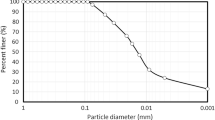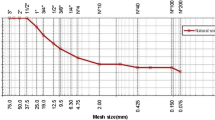Abstract
In this paper, an experimental study was carried out to evaluate the geotechnical properties of clayey soil stabilized using lime and prosopis fibers. In the present study, the fibers used were at 0.0, 0.25, 0.50, 0.75 and 1.0% by weight of the soil and the amount of lime used was kept constant as 4%. From the test results, it was inferred that the optimum content of lime and prosopis fibers required to achieve superior geotechnical properties in clayey soil was found to be 4 and 1%. At this optimum combination, unconfined compressive strength (UCS) increases by 73.5%, California bearing ratio (CBR) resistance increases by 51.9% and linear shrinkage decreases by 69% when compared to the natural soil. Formation of cementitious compounds upon addition of lime and better interlocking of soil grains by prosopis fibers contributed to the significant improvement in the properties of clayey soil.
Access this chapter
Tax calculation will be finalised at checkout
Purchases are for personal use only
Similar content being viewed by others
References
Uppal, H.L., Chadda, L.R.: Physico-chemical changes in the lime stabilization of black cotton soil (India). Eng. Geol. 2(3), 179–189 (1967)
Ayeldeen, M., Kitazume, M.: Using fiber and liquid polymer to improve the behaviour of cement stabilized soft clay. Geotext. Geomembr., 1–11 (2017)
Chen, M., Shen, S.L., Arulrajah, A., Wu, H.N., Hou, D.W., Xu, Y.S.: Laboratory evaluation on the effectiveness of polypropylene fibers on the strength of fiber reinforced and cement stabilized shanghai soft clay. Geotext. Geomembr., 1–9 (2015)
Burkart, A.: A monograph on the genus Prosopis (Leguminosae subfam Mimosoideae). (Part 1 and 2). Catalogue of the recognized species of Prosopis. J. Arnold Arboretum 57, 219–249, 450–525 (1976)
Pasiecznik, N.M., Vera-Cruz, M.T., Harris, P.J.C.: Prosopis juliflora withstands aridity and goat browsing in the Republic of Cap Verde. Nitrogen Fixing Tree Res. Rep. 13, 89–91 (1995)
ASTM D2487-17: Standard Practice for Classification of Soils for Engineering Purposes (Unified Soil Classification System). ASTM International, West Conshohocken, PA (2017)
IS: 2720-5: Determination of Liquid and Plastic Limit. Bureau of Indian Standards publications, New Delhi (1985)
IS: 2720-5: Determination of pH Value. Bureau of Indian Standards publications, New Delhi (1987)
IS: 2720-26: Determination of Water Content-Dry Density Relation Using Light Compaction. Bureau of Indian Standards publications, New Delhi (1985)
IS: 2720-10: Determination of Unconfined Compressive Strength. Bureau of Indian Standards publications, New Delhi (1991)
I.S. 2720-16: Indian Standard for Laboratory Determination of CBR. Bureau of Indian Standards publications, New Delhi (1997)
I.S. 2720-20: Indian Standard for Laboratory Determination of Linear Shrinkage. Bureau of Indian Standards publications, New Delhi (1992)
I.S. 2720-15: Indian Standard for Laboratory Determination of Consolidation Properties. Bureau of Indian Standards publications, New Delhi (1986)
Muhmed, A., Wanatowski, D.: Effect of lime stabilisation on the strength and microstructure of clay. IOSR J. Mech. Civil Eng. 6(3), 87–94 (2013)
Yadav, J.S., Tiwari, S.K.: A study on the potential utilization of crumb rubber in cement treated soft clay. J. Build. Eng. 9, 177–191 (2017)
Yadav, J.S., Tiwari, S.K.: Behaviour of cement stabilized treated coir fiber reinforced clay-pond ash mixtures. J. Build. Eng. 8, 131–140 (2016)
Ates, A.: Mechanical properties of sandy soils reinforced with cement and randomly distributed glass fibers (GRC). Compos. B 96, 295–304 (2016)
Tang, C., Shi, B., Gao, W., Chen, F., Cai, Y.: Strength and mechanical behavior of short polypropylene fiber reinforced and cement stabilized clayey soil. Geotext. Geomembr. 25, 194–202 (2007)
Yadav, J.S., Tiwari, S.K.: Effect of waste rubber fibers on the geotechnical properties of clay stabilized with cement. Appl. Clay Sci. 149, 97–110 (2017)
Rao, S.M., Shivananda, P.: Compressibility behavior of lime-stabilized clay. Geotech. Geol. Eng. 23, 309–319 (2005)
Author information
Authors and Affiliations
Corresponding author
Editor information
Editors and Affiliations
Rights and permissions
Copyright information
© 2019 Springer Nature Switzerland AG
About this paper
Cite this paper
Rudramurthy, G., Ramasamy, P., Rajendran, A. (2019). Stabilization of Clayey Soil Using Lime and Prosopis Fibers. In: Kallel, A., et al. Recent Advances in Geo-Environmental Engineering, Geomechanics and Geotechnics, and Geohazards. CAJG 2018. Advances in Science, Technology & Innovation. Springer, Cham. https://doi.org/10.1007/978-3-030-01665-4_60
Download citation
DOI: https://doi.org/10.1007/978-3-030-01665-4_60
Published:
Publisher Name: Springer, Cham
Print ISBN: 978-3-030-01664-7
Online ISBN: 978-3-030-01665-4
eBook Packages: Earth and Environmental ScienceEarth and Environmental Science (R0)




